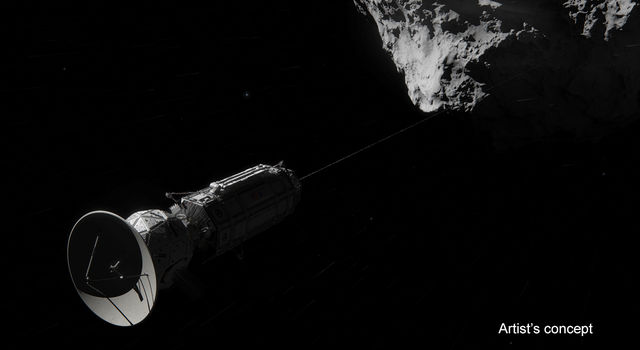Hitchhiker's Guide to the Galaxy: NASA Offers Harpoon Spacecraft Concept

“I hinted slightly to you what the whaling business is.” So how so? Still addicted to him?
- Yes, sir.
- Very well. And now answer, only quickly: can you throw the harpoon into the mouth of a live whale, and after the harpoon you can jump there yourself?
“Yes, sir, if it is absolutely necessary, that is, if it cannot be done without it ... of which I strongly doubt it.”
- Alright, alright. But you didn’t decide to go to whalers not only to find out what kind of whaling is, you also want to see the world, - so, it seems, you put it?
- Herman Melville, Moby Dick
Engineers from the NASA's Jet Propulsion Laboratory have proposed a method by which a research ship can travel in space using the kinetic energy of asteroids and comets. Like harpooners of the past, he will have to plant a harpoon in a celestial body, and gradually pull himself towards him, increasing his speed.
As the experience of using the Fila descent vehicle showed , landing on small celestial bodies is not an easy task, since their gravitational attraction is extremely small. Instead of gravity, it is necessary to use a different force that allows you to get closer to a comet or an asteroid.
Leading researcher in this work, Masahiro Ono, said that he was inspired by the book “Hitchhiker's Guide to the Galaxy”, working on this concept. In this regard, the agency named the project "Comet Hitchhiker" (Comet Hitchhiker).
“Auto-stop of a celestial body with just one thumb raised up will not work - it moves with astronomical speed, and will not stop for your sake. Instead of the thumb, we decided to use the harpoon and harness, ”Ono says.
Instead of using chemical fuel for maneuvering, the reserves of which would have to be dragged around, a hitchhiker could lasso a suitable comet and release the cable - just like a fisherman, catching a large fish, releases a fishing line with a slight tension. This allows the fish - that is, the comet, to gradually transfer its kinetic energy to the research probe. Thus, he can gradually pull himself up and sit on a heavenly body.

If you make this system reusable, then such a ship could theoretically examine several celestial bodies whose orbits will conveniently intersect. For example, having reached the Kuiper belt, the device will be able to study the many asteroids living there. And riding on a suitable comet will be able to rush even beyond the limits of the solar system.
Scientists calculated a similar situation on a computer and deduced what they called the “space hitchhiker's equation” - a combination of parameters such as the ratio of the masses of the celestial body and the probe, the difference in their speeds and the strength of the cable necessary to perform the maneuver.
According to scientists, it turns out that to "catch" a comet whose speed exceeds the speed of the spacecraft by 1.5 km / s, it is possible to make a cable from existing materials (Kevlar, or Zylon - a competitor to Kevlar, which exceeds it in tensile force by 1 , 6 times). And for a speed difference of 10 km / s there are no suitable cables so far - for this you will have to make a cable from something like carbon nanotubes, and a harpoon from a material similar to diamond.
In this case, the device must be stocked with a cable with a length of 100 to 1000 km, so that it can be released long enough, gradually gaining the necessary speed. In addition to the tensile force of the cable, it will be necessary to have sufficient elasticity to damp jerks and strength so as not to be torn by crazy pieces of microasteroids.
So far, researchers are preparing to start testing such systems at landfills.
